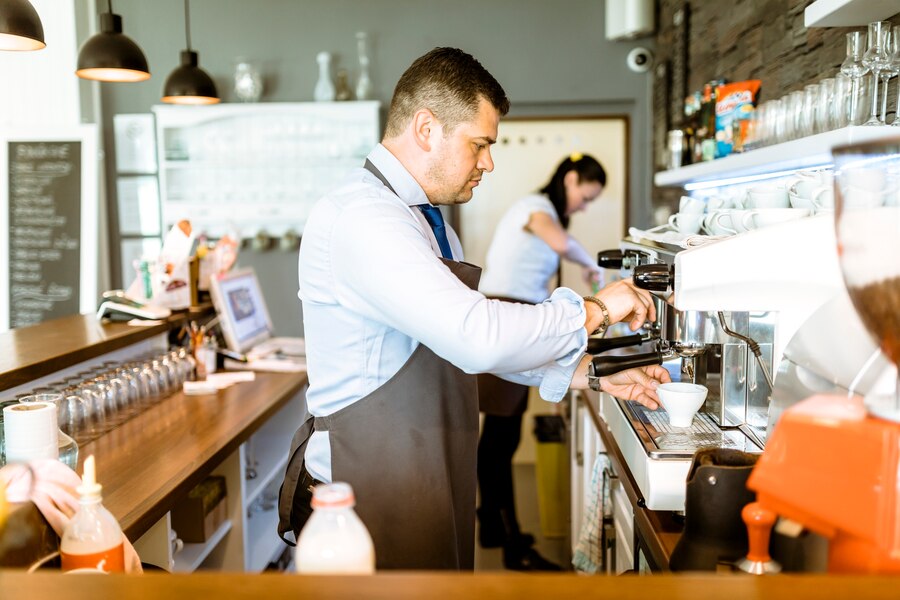In the dynamic world of culinary ventures, the success of a restaurant often hinges on the efficiency of its kitchen. A well-equipped kitchen not only ensures the seamless preparation of delectable dishes but also contributes significantly to the overall dining experience. This guide aims to underscore the paramount importance of well-equipped kitchens in restaurants, outlining the purpose and scope of the document while providing an overview of the essential equipment selection.
Kitchen Essentials
Commercial Refrigeration: Keeping Ingredients Fresh
One of the foundational elements of a restaurant kitchen is commercial refrigeration. From perishable ingredients to fresh produce, investing in reliable refrigeration ensures the preservation of food items, maintaining their quality and safety for culinary use.
High-Quality Cooking Appliances: Stoves, Ovens, And Grills
Cooking appliances form the beating heart of any kitchen. Whether it’s the precision of a stove, the versatility of an oven, or the searing power of a grill, high-quality cooking appliances are indispensable for crafting a diverse and flavorful menu.
Ventilation Systems: Ensuring A Comfortable And Safe Kitchen
A comfortable and safe kitchen environment is crucial for the well-being of both chefs and diners. Ventilation systems play a pivotal role in maintaining optimal air quality, removing excess heat, and safeguarding against the buildup of fumes and odors.
Food Preparation Stations: Sinks, Counters, And Cutting Surfaces
Efficient food preparation requires well-designed stations equipped with sinks, ample counter space, and cutting surfaces. These elements contribute to a streamlined workflow, allowing chefs to focus on creating culinary masterpieces.
Storage Solutions: Shelving And Cabinets For Organization
An organized kitchen is a productive kitchen. Adequate storage solutions, including shelving and cabinets, facilitate efficient inventory management, ensuring that ingredients are easily accessible and reducing clutter in the cooking space.
Read Also: 9 Fulfillment Tips For Your Success In E-Commerce
Front-Of-House Necessities
Welcoming Reception: Essential Furniture And Decor
The dining experience begins at the front of the house, where a welcoming reception area sets the tone. Essential furniture and decor, thoughtfully chosen, create an inviting ambiance that enhances the overall guest experience.
Point Of Sale (Pos) Systems: Streamlining Transactions
Streamlining transactions is essential for both customers and staff. Point of Sale (POS) systems not only facilitate smooth and quick transactions but also contribute to accurate order management and inventory tracking.
Quality Serving Ware: Plates, Utensils, And Glassware
The presentation of dishes plays a crucial role in the overall dining experience. Investing in quality serving ware, including plates, utensils, and glassware, elevates the visual appeal of meals and enhances customer satisfaction.
Beverage Equipment: Coffee Makers, Dispensers, And Bar Tools
Beverages are often an integral part of the dining experience. From coffee makers to dispensers and bar tools, having the right beverage equipment ensures that patrons enjoy a delightful array of drinks to complement their meals.
Lighting And Ambiance: Creating A Pleasant Dining Experience
Beyond the tangible elements, the ambiance of the dining space significantly influences customer perceptions. Thoughtful lighting and ambiance considerations contribute to creating a pleasant and memorable dining experience.
Safety And Maintenance Equipment
Fire Safety Measures: Extinguishers, Alarms, And Suppression Systems
Ensuring a safe kitchen environment involves implementing robust fire safety measures. Fire extinguishers, alarms, and suppression systems are critical components that mitigate the risk of fires and protect both staff and patrons.
First Aid Stations: Ensuring A Safe Environment For Staff And Guests
Prioritizing safety extends beyond fire prevention. First aid stations equipped with essential medical supplies create a safe environment, addressing minor injuries promptly and ensuring the well-being of both staff and guests.
Cleaning And Sanitization Equipment: Dishwashers, Sinks, And Cleaning Supplies
Maintaining a high level of hygiene is paramount in the food service industry. Cleaning and sanitization equipment, including dishwashers, sinks, and cleaning supplies, play a pivotal role in upholding cleanliness standards and ensuring food safety.
Regular Maintenance Tools: Extending The Lifespan Of Equipment
To prolong the lifespan of valuable equipment, regular maintenance is key. Employing the right tools for routine checks and minor repairs helps prevent breakdowns, reducing downtime and contributing to overall operational efficiency.
Protect Your Investment: The Role of Restaurant Insurance
Running a restaurant is as much about preparation as it is about protection. While fire extinguishers, first aid kits, and cleaning supplies can maintain a safe and functional kitchen, restaurant insurance can provide an essential safety net for the unexpected. From covering equipment damage due to accidents to protecting against liability issues, having the right New Jersey Restaurant Insurance plan, or elsewhere, can ensure that your investment remains secure. Whether it’s fire, theft, or unforeseen interruptions, a comprehensive insurance policy can safeguard your business, staff, and peace of mind.
Technology Integration
Smart Kitchen Appliances: Enhancing Efficiency with Technology
Embracing technology in the kitchen enhances operational efficiency. Smart kitchen appliances, equipped with advanced features and connectivity, streamline processes, reduce manual effort, and contribute to a more efficient workflow.
Inventory Management Systems: Streamlining Stock Control
Efficient stock control is crucial for minimizing waste and optimizing costs. Inventory management systems provide real-time insights into stock levels, helping restaurants make informed decisions, reduce overstock, and maintain a well-managed supply chain.
Reservation And Booking Platforms: Optimizing Customer Service
Providing exceptional customer service starts with effective reservation and booking platforms. These systems not only streamline the reservation process but also contribute to personalized customer experiences, ultimately enhancing overall satisfaction.
Online Ordering Systems: Adapting To Modern Dining Trends
Modern dining trends emphasize convenience, and online ordering systems cater to this shift. Implementing user-friendly online ordering platforms enables restaurants to reach a wider audience, adapt to changing consumer preferences, and boost revenue.
Budgeting And Prioritization
Assessing Budgetary Constraints: Making Informed Equipment Choices
Navigating budget constraints requires strategic decision-making. Assessing budgetary constraints helps restaurant owners make informed equipment choices, ensuring that investments align with financial realities while meeting operational needs.
Prioritizing Essential Purchases: A Step-By-Step Guide
Prioritization is crucial when making equipment purchases. A step-by-step guide assists restaurant owners in prioritizing essential purchases based on immediate needs, long-term goals, and the overall vision for the establishment.
Long-Term Planning: Scaling Equipment As The Restaurant Grows
Effective planning extends beyond immediate needs. Long-term planning involves anticipating growth and scaling equipment accordingly. This strategic approach ensures that investments align with the evolving needs of the restaurant as it expands.
Regulatory Compliance And Licensing
Meeting Health And Safety Standards: Essential Compliance Measures
Compliance with health and safety standards is non-negotiable in the restaurant industry. Understanding and implementing essential compliance measures ensures that the establishment meets regulatory requirements, fostering a safe and legally sound operation.
Licensing Requirements: Navigating Legal Obligations
Navigating licensing requirements is a critical aspect of running a restaurant. Complying with legal obligations ensures that the establishment operates within the bounds of the law, avoiding potential legal issues and safeguarding the business.
Environmental Considerations: Sustainable Practices In Equipment Choices
As sustainability gains prominence, considering environmental factors in equipment choices is essential. Embracing sustainable practices, from energy-efficient appliances to eco-friendly materials, aligns the restaurant with environmentally conscious trends.
In the pursuit of regulatory compliance and seamless operations, having access to corporate office information is pivotal. If you’re seeking details on corporate offices Check HeadquarterLocation. This resource not only enhances administrative capabilities but also streamlines communication for optimal efficiency.
Case Studies: Success Stories In Restaurant Equipment Investments
Profile Of A Successful Restaurant: Equipment Choices And Business Outcomes
Exploring success stories provides valuable insights into how strategic equipment choices contribute to business outcomes. Profiling a successful restaurant showcases the correlation between specific equipment investments and overall success.
Learning From Challenges: Case Studies On Equipment-Related Setbacks
Examining challenges and setbacks in case studies offers lessons for improvement. Learning from instances where equipment choices led to difficulties helps restaurant owners avoid common pitfalls and make more informed decisions.
Conclusion
Recap Of Key Equipment Considerations
Summarizing the key equipment considerations highlighted throughout the guide reinforces the importance of a holistic approach to restaurant equipment selection.
Recommendations For New Restaurant Owners
Offering practical recommendations for new restaurant owners consolidates key takeaways, providing actionable insights for navigating the complexities of equipment selection and management.
Looking Ahead: Future Trends In Restaurant Equipment
Anticipating future trends in restaurant equipment offers a forward-looking perspective, helping restaurant owners stay ahead of industry developments and emerging technologies.
Feel free to customize and expand upon these sections based on your specific requirements and preferences.
Additional Reading:






Leave A Comment